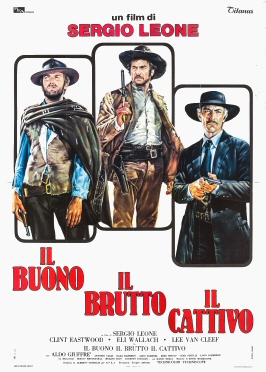
The Good, The Bad, and The Ugly
Let me lay out this twisted treasure hunt of a Western, where everyone’s moral compass spins like a broken slot machine!
The story kicks off during the Civil War, introducing us to our three protagonists – though “protagonists” might be stretching it for at least two of them. There’s “Blondie” (Clint Eastwood) who’s “the Good,” though his goodness seems mainly to consist of being slightly less awful than everyone else. Then there’s Angel Eyes (Lee Van Cleef), “the Bad,” who will cheerfully kill anyone as long as he’s been paid for it (he’s very professional about his awfulness). And finally, there’s Tuco (Eli Wallach), “the Ugly,” a fast-talking bandit who’s about as trustworthy as a rattlesnake in a sock drawer.
The film opens with Blondie and Tuco running a scam where Blondie turns in Tuco for the bounty, then shoots the rope at his hanging (usually waiting until the last possible second, because apparently Blondie has a flair for the dramatic). They split the money and move on to the next town. That is until Blondie decides to end their partnership by abandoning Tuco in the desert – which, as far as workplace resignations go, is pretty extreme.
Tuco survives (because cockroaches and Tuco are nature’s great survivors) and spends the next portion of the movie trying to get revenge on Blondie. This leads to him forcing Blondie to walk through the desert without water, which seems fair – though you’ve got to wonder if these guys have heard of mediation.
The plot kicks into high gear when they stumble across a dying Confederate soldier who reveals the location of $200,000 in Confederate gold. The catch? He tells Tuco the name of the cemetery where it’s buried and tells Blondie the name on the grave. Now they’re forced to work together, which goes about as well as you’d expect for two guys who just finished trying to kill each other.
Enter Angel Eyes, who’s been tracking this gold too. What follows is a three-way dance of alliances, betrayals, and Mexican standoffs, all while the Civil War rages around them like an inconvenient background event. Our three anti-heroes keep crossing paths with the war, getting wrapped up in prison camps and battles, though they remain impressively focused on their gold hunt despite the minor distraction of America tearing itself apart.
It all culminates in the famous three-way showdown in a massive circular graveyard, because if you’re going to have a Mexican standoff, you might as well do it somewhere photogenic. After enough tension to snap a piano wire, Blondie emerges victorious, sharing the gold with Tuco – except he’s left Tuco’s share out of reach while he’s tied up, because old habits die hard.
The whole thing is set to Ennio Morricone’s iconic score, which manages to turn “wah-WAH-wah” into high art. The film basically created the template for every subsequent movie where people squint at each other while pointing guns, which turns out to be quite a few movies.
And there you have it – a story that proves that maybe the real treasure was the enemies we made along the way, and that having a cool theme song makes everything you do about 300% more awesome.
5 Pistoleros out of 5. I’ll admit I love a good western – the genre has thinned out in recent years and not all of them a great but this is Clint Eastwood in his prime and he’s facing off against a great supporting cast (much better than that chair on the stage). The score is iconic – ecstasy of gold is right up there with what I consider one of the most iconic movie songs of all time (first place if you pretend John Williams doesn’t exist) [do yourself a favor and listen to Metallica’s cover if you haven’t its amazing]
If I didn’t have a series of other things to do this year – this would have probably knocked me into a Western movie rabbit hole. I still might go on one after this challenge is over because this movie is still resonating with me months after I watched it.